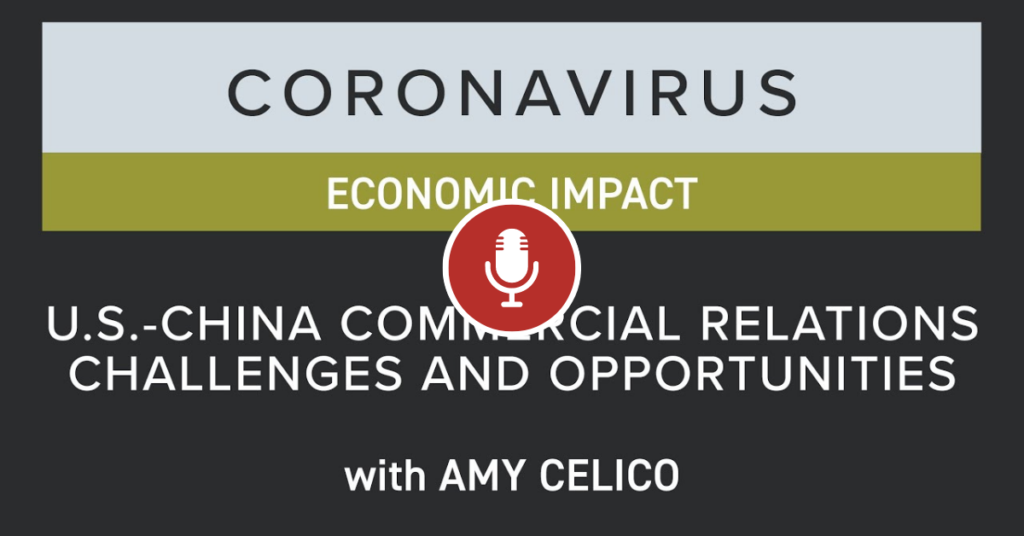This episode is part of the National Committee’s Coronavirus Impact Series.
Principal of Albright Stonebridge Group Amy Celico explains the fundamental challenges currently facing the bilateral commercial relationship between the United States and China. She also discusses why the “phase one” trade deal is a positive development and how COVID-19 is highlighting the role of foreign investors in China’s economic growth trajectory.
Speaker Bio
Amy Celico is a principal at the Albright Stonebridge Group (ASG) and leads the firm’s D.C.-based China practice, assisting corporate and non-profit clients develop and expand their business in China. Previously, Ms. Celico served as senior director for China affairs at the Office of the US Trade Representative and worked at the U.S. Departments of Commerce and State, including as a diplomat stationed in Beijing and Shanghai. Ms. Celico serves on the Board of Directors of the National Committee on U.S.-China Relations and is a senior associate (non-resident) at the Center for Strategic and International Studies.
Ms. Celico earned a B.A. with honors in Asian studies from Mount Holyoke College and completed her M.A. in international economics and strategic studies at the Johns Hopkins School of Advanced International Studies. She is also a graduate of the Hopkins-Nanjing Center in China.
Transcript
Amy Celico: Let me dive right in. I’ll say something pretty obvious to everybody, but I think it’s really important to underscore. Here in 2020, the bilateral commercial relationship between the United States and China is incredibly challenged. In fact, it’s hard to think of a time when this, what used to be described as the ballast or the stabilizer of the overall relationship has been so fraught . This leads me to be pretty sober about the prospects for this aspect of the relationship in the long-term, but I do think COVID-19, in addition to the many, many challenges it brings, also does present some opportunities for the economic relationship.
Let me be frank: In China, in the United States, and across the globe, the stakes for the economic relationship have been raised dramatically by COVID-19. But, let’s first assess where we are. Despite so much opportunity and interest in bilateral economic activity among our companies, our universities, and localities in both countries, including significant revenues that have been generated from bilateral goods and services trade, the commercial relationship between the United States and China continues to struggle with fundamental challenges.
As you know, there are longstanding accusations against China of depriving American and other foreign investors of a level playing field to compete in the China market through the use of protectionist and unfair trade practices that distort global markets. More recently, the U.S. g overnment has been accused of allowing an overzealous bleeding of national security issues into economic policymaking to ramp up investment restrictions, export controls, and other limitations on technology trade that are unduly impacting American competitiveness. They’re also depriving local economies across the United States of investors and not making the United States more secure in the process.
Amy Celico: On both sides of the Pacific, there’s been a tit for tat application of tariffs on trade flows that has impacted more than $700 billion in goods flowing between our two countries over the past almost two years of a trade war. Tariffs that were justified in the United States not only to bring China to the negotiating table on trade and market access issues but also to help promote a broader economic decoupling of our interconnected economies on political and economic grounds.
Even before COVID-19 put an even bigger strain on this element of the relationship, commercial ties between our two countries have been in dire straits. These restrictions placed on trade by our governments have led companies to accelerate a process of diversifying, I’ll say, rather than decoupling, where and how they source goods and services. Against this backdrop, let me at least highlight two positive things in 2020 vis-a-vis the economic relationship. First is with regard to the trade agreement between the United States and China.
This phase one trade agreement, given how negative the economic relationship had become, was very, very warmly welcomed by the U.S. business community. Three months ago, yesterday, it was signed, and it was a very positive development if for no other reason than it took some of the tension out of the economic relationship. But, of course, the agreement was limited. While indeed it had some very good elements, it also had flaws. It focused on purchase agreements that can only be characterized, particularly by our other trading partners, as managed trade. It also left many of our other trading partners deeply troubled by the weight of those significant and unrealistic purchase agreements of agriculture, energy goods, services, and manufactured goods on their own ability to trade with China this year and next year.
Amy Celico: These commitments to purchase an additional $200 billion in U.S. goods and services over the next two years over 2017 levels were unrealistic in January. Today, of course, it would be frankly impossible to achieve due to COVID-19, although we did, just overnight, get good economic data about agricultural trade with China over the past two months, mainly due to increased purchases by China of soybean and pork. But, I think one of the biggest shortcomings of the phase one trade agreement was: it left most of the tariffs in place. W hile the U.S. Government has stressed this is necessary to use as leverage for phase two trade negotiations, it impacts even the current purchase commitments that China has made, since the tariffs still apply to most of the purchases of U.S. farm goods, energy products. This squeezes the margins for U.S. sellers.
But, as I said, let me at least highlight one positive element of the phase one trade agreement. As we’ve seen over the past three months since the deal was signed, this phase one trade agreement has offered a very important area of productive cooperation between the United States and China. Implementation of the commitments made in January have been moving forward according to the U.S. Trade Representative, the Treasury Secretary, President Trump, and President Xi, of course, and our two ambassadors. Despite increased tensions in the overall relationship and, now the global health pandemic that we face, this at least has been one area where the U.S. and China can point to progress.
My former colleagues at the U.S. Trade Representative’s office have pointed to progress that China has made on process and on substance. In addition to purchase commitments, the Chinese government has made some market liberalization announcements per the terms of the agreement on schedule. Where COVID-19 has impacted some other commitments that China was due to make, mainly because the National People’s Congress didn’t meet on schedule in March, China continues to talk in a very fulsome manner about how it will continue to make these market access commitments come to life for American companies.
Amy Celico: As I said before, the agreement is far from perfect. It keeps most of the tariffs in place and saves most of the very difficult but critical issues in the bilateral relationship to future phase two negotiations. Phase two negotiations that in the current political and now global economic climate are very unlikely to happen anytime soon. But, given where we are today due to COVID-19, this agreement was important in that it did reestablish channels of communication on economic issues between the United States and China. It’s worth highlighting and celebrating since we’re going to need these channels in the coming months. Maybe that’s not a huge positive, but it’s a necessary one, and we should pocket it and put these channels of communication to good use in the months ahead.
My second and final point that I’d like to highlight is about the business climate in China. One of the very, very few silver linings of COVID-19 has been that it seems to have reinforced and reinvigorated talk on the ground in China about the important role of foreign investors in China’s growth trajectory. While last May through the end of 2019, we were hearing threats from the Chinese government about the unveiling of an unreliable entities list, increasing calls for self-reliance, both in response to U.S. government actions, now we’re seeing China rolling out assistance and reassurance to foreign and domestic companies as the government grapples with the devastating impact of COVID-19. In the wake of the pandemic, Chinese officials have been assisting foreign companies with supply chain bottlenecks and helping them to restart production.
China continues to talk about plans to expand market access for foreign insurance providers to release a new and shorter negative list of the sectors of the economy that are closed to foreign investment and take further steps to open new parts of the economy to foreign investors. Of course, COVID-19 is pushing a new conversation about the vulnerability of global supply chains, which we can get into later. But, I do want to end by just saying, again, how promising it is that the Chinese government, in what is going to be a dramatically and historically bad year for the Chinese economy, is highlighting the role of foreign investors and the role of trade in China’s recovery efforts. I only hope that our two countries together will take action in that same spirit, perhaps by eliminating more of the tariffs that remain in place to help our economies recover and deal with this pandemic. I’ll leave it there, Steve. Thanks so much.

